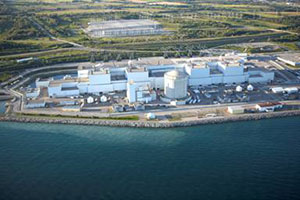Nuclear power plants
The Canadian Nuclear Safety Commission (CNSC) regulates all stages of the life of each nuclear power plant in Canada, from the environmental assessment required before plant construction, to the decommissioning of the facility once operations are ended.
- Operating nuclear power plants
- Refurbishment and life extension
- New reactor facility projects
- Decommissioning activities
Operating nuclear power plants
Nuclear power plants have been producing electricity commercially in Canada since the early 1960s. Today, five plants in three provinces house 22 nuclear power reactors. Nuclear energy produces about 15 percent of Canada's electricity. The CNSC has a team of technical experts and onsite inspectors to ensure that rigorous oversight of plant operation is maintained, in order to protect the public and the environment.
Operating facilities and the communities:
- Bruce Nuclear Generating Station, Ontario
- Pickering Nuclear Generating Station, Ontario
- Darlington Nuclear Generating Station, Ontario
- Gentilly-2 Nuclear Facility, Québec (recently shut down)
- Point Lepreau Generating Station, New Brunswick
All nuclear power reactors in Canada are CANDU (Canadian Deuterium-Uranium) reactors. These pressurized heavy water reactors use natural uranium as fuel and heavy water as a coolant and moderator.
CNSC licensing of plants is comprehensive and covers 14 separate topics referred to as safety and control areas , such as radiation protection, emergency preparedness, environmental protection and equipment fitness for service.
The CNSC assesses licence applications to ensure that safety measures are technically and scientifically sound, that all requirements are met, and that the appropriate safety systems are in place to protect people and the environment.
 Aerial photograph of the Darlington Nuclear Generating Station located near
Bowmanville, Ontario
Aerial photograph of the Darlington Nuclear Generating Station located near
Bowmanville, Ontario
The licensing process offers significant opportunities for public participation, including Commission hearings and community meetings that are open to the public and webcast live.
After a licence is issued, the CNSC stringently evaluates compliance. In addition to having a team of onsite inspectors, CNSC staff with specific technical expertise regularly visit plants to verify that operators are meeting the regulatory requirements and licence conditions.
The CNSC carefully reviews any items of non-compliance and follows up to ensure all items are quickly corrected. Previously, the CNSC published annually, a regulatory oversight report (ROR) for Canadian nuclear power plants . In 2018, for the first time, the CNSC assessed the safety performance not only of Canada’s nuclear power plants, but also of adjacent waste management facilities in 2017. The results are published in the Regulatory Oversight Report for Canadian Nuclear Power Generating Sites: 2017 .
The CNSC also collaborates with international partners, including the International Atomic Energy Agency and its foreign counterparts. Every three years, the CNSC publishes a comprehensive report as part of the Convention on Nuclear Safety , following up on its commitment to maintain a high level of safety at all nuclear power plants.
Did you know?
The CNSC requires licensees of major nuclear facilities to develop and implement public information programs to keep the public in their community informed about their nuclear activities and any potential related impact on public health and the environment
New reactor facility projects
New reactor facility projects are being considered in some parts of Canada.
When the CNSC receives an application for a new plant, its experts work in multidisciplinary teams to undertake an environmental assessment and a technical assessment, using the same 14 safety and control areas that form the basis of any future licensing and regulatory oversight.
Decommissioning activities
The CNSC regulates the entire lifecycle of nuclear power plants. Decommissioning activities are the actions a licensee undertakes at the end of the useful life of the reactor. The decision to stop operating and to decommission the reactor is taken solely by the licensee.
The CNSC's role is to ensure that decommissioning activities are carried out in accordance with CNSC regulatory requirements to ensure protection of the workers, the public and the environment, and to implement Canada's international commitments on the peaceful use of nuclear energy.
Plans related to the decommissioning of nuclear power plants take, on average, 50 years to completely implement. As a requirement for obtaining a licence to operate a nuclear power plant, the operator must submit a decommissioning plan that outlines how the operator plans to manage the dismantling of the plant.
The financial guarantee, which is based on this plan, is also used by the CNSC to evaluate how the operator will guarantee financing for decommissioning activities.
 Gentilly-1 and Gentilly-2, Bécancour, Québec.
Gentilly-1 and Gentilly-2, Bécancour, Québec.
Under a normal operating licence, the operator can place the nuclear facility in safe storage, if it so wishes, as an initial step to decommissioning.
The Gentilly-2 Nuclear Power Plant in Bécancour, Québec, recently shut down and will soon take this step. Units 2 and 3 of the Pickering Nuclear Generating Station, Pickering, Ontario, are already in safe storage.
Three prototype nuclear reactors constructed and owned by Atomic Energy of Canada Limited were shut down and prepared for decommissioning in the 1980s in Rolphton and Kincardine, Ontario and in Bécancour (Gentilly-1).
Today, the CNSC continues to license these facilities as waste management facilities , which continue to safely store radioactive waste onsite. Funding to proceed with the decommissioning activities is provided by Canada's Nuclear Legacy Liabilities Program .
In the future, all radioactive waste will be removed from those locations, and decommissioning will eliminate any unreasonable risks to health, safety, security and the environment. At that point, those facilities will be issued abandonment licences to release them from CNSC regulatory control.
Related links
Page details
- Date modified: